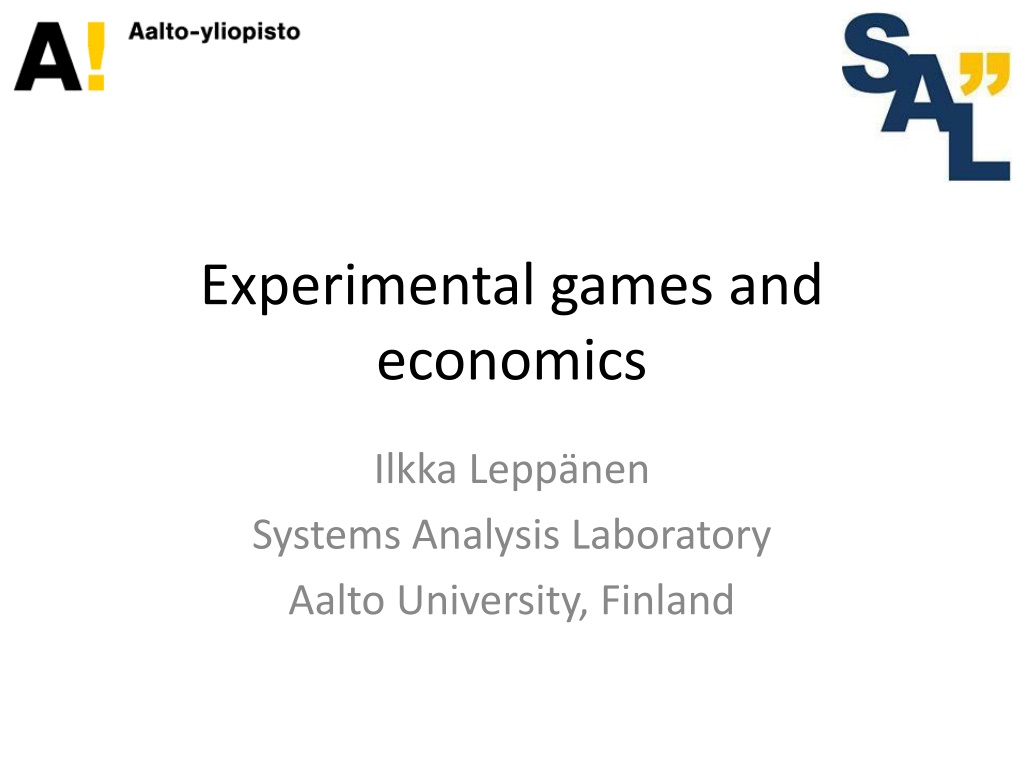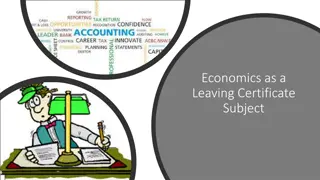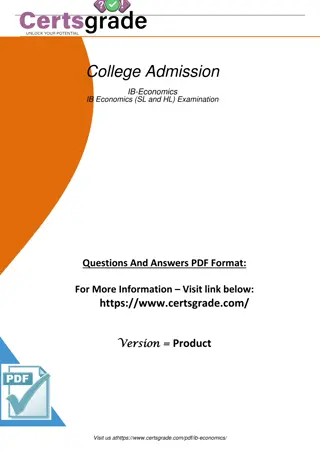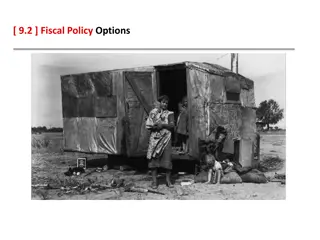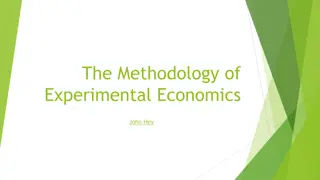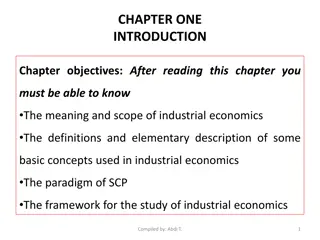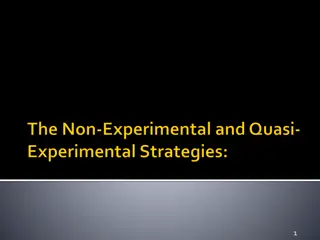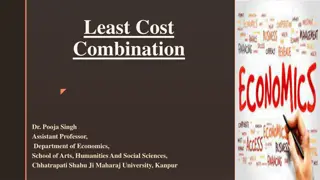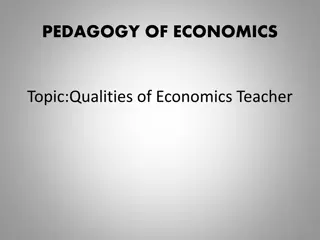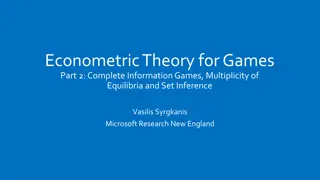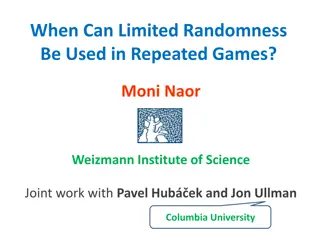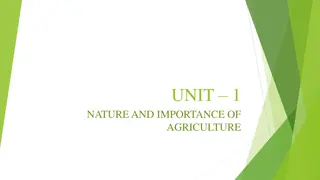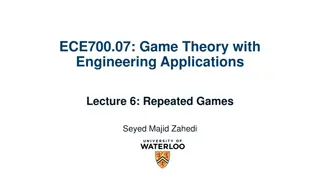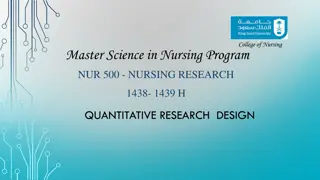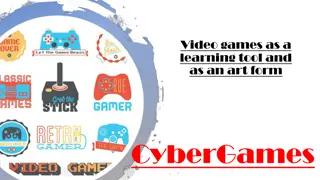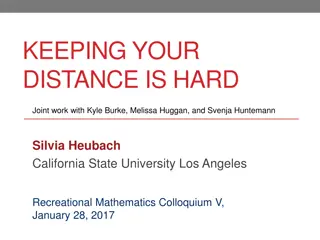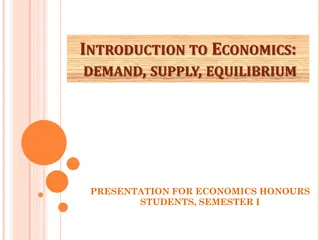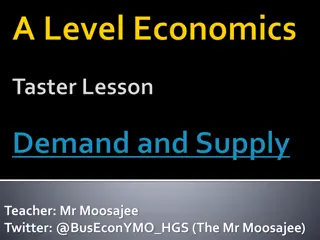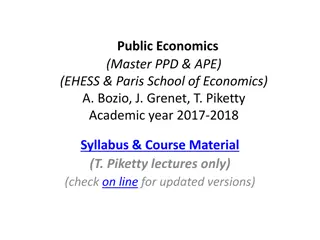Insights into Experimental Games and Economics
Explore the world of experimental games and economics, from the history of market experiments to the concept of equilibrium in game theory. Understand the purpose of experiments, how theories are validated, and the relevance of strategic situations in game analysis. Delve into the Nash equilibrium and the application of game theory in understanding human behavior and decision-making.
Download Presentation

Please find below an Image/Link to download the presentation.
The content on the website is provided AS IS for your information and personal use only. It may not be sold, licensed, or shared on other websites without obtaining consent from the author.If you encounter any issues during the download, it is possible that the publisher has removed the file from their server.
You are allowed to download the files provided on this website for personal or commercial use, subject to the condition that they are used lawfully. All files are the property of their respective owners.
The content on the website is provided AS IS for your information and personal use only. It may not be sold, licensed, or shared on other websites without obtaining consent from the author.
E N D
Presentation Transcript
Experimental games and economics Ilkka Lepp nen Systems Analysis Laboratory Aalto University, Finland
Lets do one experiment now Choose a whole number between 0 and 100 that you think is closest to 2 3* (average of everyone s number) Write it on the paper sheet with your name Fold the paper sheet and pass it forwards The one whose number is closest to the goal wins an Aalto coffee mug If there is a tie we will throw the dice
The Beauty Contest Nagel (1995) Game theory predicts: everyone chooses 0 Solution to the equation (2/3)*x = x Most often people choose in the range of 20 35 Belief hierarchy: 0thstep: choose randomly 1ststep: others are 0th 2ndstep: others are 1st
Purpose of experiments In economics there has been over-reliance on theory building Empirical realism of a theory s assumptions is not a basis for the theory s critical evaluation (Milton Friedman) In natural sciences experiments are used to falsify or validate theories Theories must produce testable hypotheses and be falsifiable
History Market experiments to test how prices are formed (1940s ) Nobel prize: Vernon Smith 2002 Game experiments to test behavior in abstract games (1950s ) Judgement and decision making under uncertainty (1960s ) Nobel prize: Daniel Kahneman 2002
What are games? Taxonomy of strategic situations A rough equivalent for social science of the periodic table of elements in chemistry (Colin Camerer) Analytical game theory uses mathematical rules to study what players possibly do in games Experimental/behavioral game theory provides evidence for what players actually do
Equilibrium The Nash equilibrium is the centerpiece of game theory (Nash, 1951) Nash equilibrium predicts that players end up into a situation in which no-one has incentive to deviate from their decision The subgame-perfect Nash equilibrium considers sequential decision making in games
Prisoners Dilemma (PD) Player 2 Payoffs: Player 1 / Player 2 C D Player 1 C 2 / 2 0 / 3 C = cooperate D = defect D 3 / 0 1 / 1 Models the problems of cooperation Both cooperating would give best mutual payoffs Unilateral defection gives best individual payoffs Both defecting is the unique Nash equilibrium The Public Goods Game (PGG): PD with 3 or more players
Battle of the Sexes (BoS) M B M 2 / 1 0 / 0 B 0 / 0 1 / 2 Models the problem of coordination Player 1 prefers M and Player 2 prefers B, but they do not want to choose different actions than the other Two Nash equilibria: both choose M and both choose B Finding out which one will prevail is perhaps the most difficult problem in game theory (C. Camerer)
Ultimatum Game (UG) Offer x from 5 Player 1 Player 2 Reject: both get 0 Accept: Player 1 gets 5 x , Player 2 gets x Models a simple bargaining situation Game theory predicts that Player 1 offers the smallest amount possible and Player 2 accepts this
Dictator Game (DG) Offer x from 5 Player 1 Player 2 Player 2 has no choice available Game theory predicts that Player 1 keeps all the money to himself
Experimental evidence on PD Subjects cooperate ~50% of the time Increasing the unilateral defection payoff decreases cooperation rates Pre-play communication between the subjects increases cooperation rates C D C 2 / 2 0 / 30 D 30 / 0 1 / 1
Experimental evidence on PGG Subjects contribute ~50% of their endowment When they play repeatedly with new opponents, contribution rates deteriorate Cooperation rates increase if subjects can punish non-contributors Fehr and G chter (2000)
Experimental evidence on BoS Subjects generally fail to coordinate Pre-play communication by one player improves coordination (Cooper et al. 1989) Relabeling the choice alternatives improves coordination by making one equilibrium more salient MMMM b MMMM 2 / 1 0 / 0 b 0 / 0 1 / 2
Equilibrium refinements Results from PD, PGG and BoS can be explained by refining the Nash equilibrium The subgame-perfect Nash equilibrium Literature on learning (Roth & Erev 1995): players in repeated games gradually adjust their choices so that they are in equilibrium In BoS one equilibrium can be focal and become selected more often than the other
Experimental evidence on UG The subgame-perfect Nash equilibrium requires backwards-induction Player 1 deduces the optimal choice by first evaluating Player 2 s choices and then own choices G th et al. (1982) wanted to find out the ability to use backwards-induction Subjects were able to use it in other games but they still offered almost equal splits in the UG Modal offer: 50%
Experimental evidence on UG and DG Forsythe et al. 1994
Experimental evidence on UG Sanfey et al. (2003) were the first to use fMRI When rejecting unfair offers, activity in deep emotional brain parts
Game theory refinements in UG? If players have the capacity to play in the UG as game theory predicts, why don t they? This points to novel phenomena that Nash equilibrium or its refinements cannot take into account Repeating the UG does not lead to the game theory prediction
Other-regarding behavior The literature on other-regarding preferences: players see games differently than the theorist The best individual utility does not result from the Nash equilibrium but from a fair payoff allocation See Cooper and Kagel (2013) UG and DG evidence conform to this idea Most Player 1 s propose fair splits Most Player 2 s accept fair splits and reject unfair splits Reciprocity: some players are conditional cooperators by nature Intentions matter: computer proposals are accepted, human proposals rejected
How to use experiments Experiments can be used to: 1. Refine existing theory (the Nash equilibrium refinements) 2. Characterize novel phenomena (the models of other-regarding preferences) Third way is to stress test and demonstrate games before they are used by policymakers and firms If a theory does not work in an experiment, it certainly does not work in real life
Stress testing theory with experiments UK government asked game theorists to design auctions for five 3G licenses Reported in Binmore and Klemperer (2002) and Abbink et al. (2005) They used experiments and found their theoretical design to be quite efficient Subjects were from companies and the government The experiments were useful in communicating the design to non-specialists
Methodological considerations Conduct pilot experiments Ensure anonymity and blindness Single-blind: subjects do not know the research question Double-blind: experimenters do not know the research question Test that subjects understand the instructions before they play the game Make sure others can replicate your results Report every detail of the experiment Ideal: write the paper before you collect the data
Use performance-based payments Money is not only a reward for participating It is used to make the experiment a real-life decision making situation Align monetary payment to success in the task Student subjects earn generally about 20 for an hour s work in the laboratory Induced valuation (Vernon Smith 1976)
Deception of subjects Strictly forbidden in experimental economics Subjects read the research papers and find out they have been deceived Deception by one laboratory can contaminate the subject pool with false beliefs about how the experiment works Economics journals do not publish experimental papers that use deception In experimental psychology and neuroscience deception is not a problem and even encouraged
Abbink, K., Irlenbusch, B., Pezanis-Christou, P., Rockenbach, B., Sadrieh, A. and Selten, R., 2005. An experimental test of design alternatives for the British 3G/UMTS auction. European Economic Review, 49, pp. 505 530. Binmore, K. and Klemperer, P., 2002. The biggest auction ever: The sale of the British 3G telecom licences. The Economic Journal, 112, pp. C74 C96. Cooper, R., DeJong, D.V., Forsythe, R. and Ross, T.W., 1989. Communication in the battle of the sexes game: Some experimental results. The RAND Journal of Economics, pp. 568 587. Cooper, D.J. and Kagel., J.H., 2013. Other-Regarding Preferences: A Selective Survey of Experimental Results. http://www.econ.ohio-state.edu/kagel/Other%20Regarding_All_2_12_13.pdf Fehr, E. and G chter, S., 2000. Cooperation and Punishment in Public Goods Experiments. American Economic Review, 90, pp. 980 994. Forsythe, R., Horowitz, J.L., Savin, N.E. and Sefton, M., 1994. Fairness in simple bargaining experiments. Games and Economic Behavior, 6, pp. 347 369. G th, W., Schmittberger, R. and Schwarze, B., 1982. An experimental analysis of ultimatum bargaining. Journal of Economic Behavior & Organization, 3, pp. 367 388. Nagel, R., 1995. Unraveling in guessing games: An experimental study. The American Economic Review, 85, pp. 1313 1326. Nash, J., 1951. Non-cooperative games. Annals of Mathematics, pp. 286 295. Roth, A.E. and Erev, I., 1995. Learning in extensive-form games: Experimental data and simple dynamic models in the intermediate term. Games and Economic Behavior, 8, pp. 164 212. Sanfey, A.G., Rilling, J.K., Aronson, J.A., Nystrom, L.E. and Cohen, J.D., 2003. The neural basis of economic decision-making in the ultimatum game. Science, 300, pp. 1755 1758. http://science.sciencemag.org/content/300/5626/1755.full Smith, V.L., 1976. Experimental economics: Induced value theory. The American Economic Review, 66, pp. 274--279.
